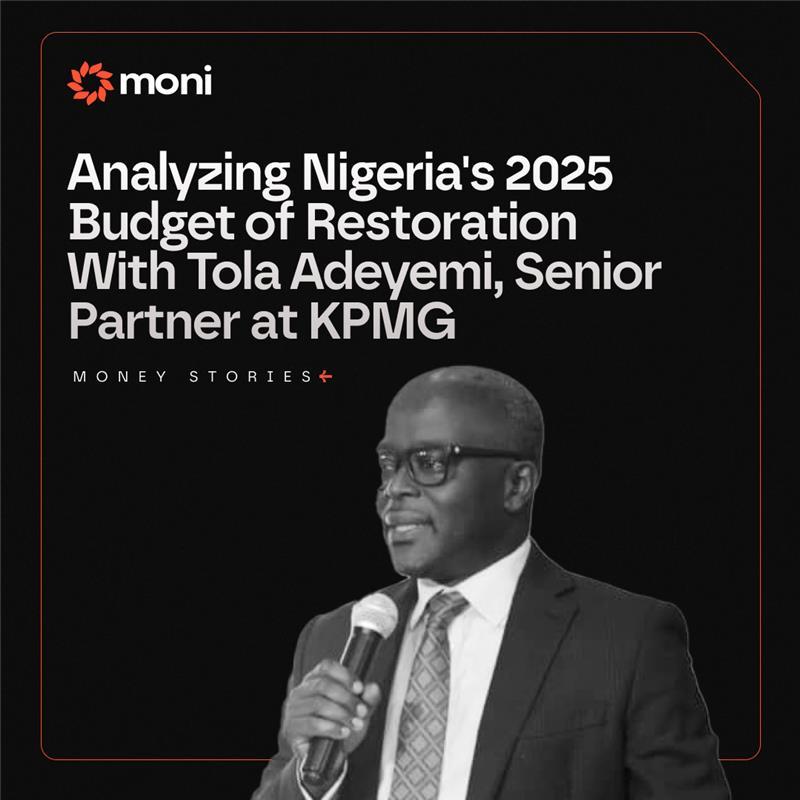
Nigeria’s 2025 budget, tagged the “Budget of Restoration,” has sparked widespread discussion across economic and policy circles. With a proposed expenditure of ₦55.49 trillion, it is an ambitious and expansionary plan designed to stimulate economic growth. At the recent KPMG X Arise News 2025 Budget Day discussion, Tola Adeyemi, Senior Partner at KPMG, provided expert commentary on Nigeria’s new fiscal plans. He broke down the key aspects of revenue generation, expenditure, debt servicing, and the government’s broader economic intent.
A Budget of Expansion and Deficit
According to Adeyemi, one of the most striking aspects of the budget is its expansionary nature. All major indices are trending upwards, signaling the federal government’s intent to stimulate the economy through increased spending. However, the budget also comes with a deficit, meaning planned expenditures will exceed revenues.
“The point has been made several times that a deficit is not bad in itself,” Adeyemi noted. “It all depends on where the funds are being directed.”
The key question, then, is how the deficit will be financed and whether the government’s borrowing plans are sustainable.
Revenue Projections: The Role of Oil and Taxes
Adeyemi’s analysis started with the revenue side of the budget, where the Federal Government of Nigeria’s share of net federal revenue is expected to rise significantly. This increase stems from two primary factors: the devaluation of the naira, which boosts oil revenue in local currency terms and a projected increase in oil production, with the government targeting 2.12 million barrels per day—a step up from previous years.
On non-oil revenues, Adeyemi pointed to taxation as a major driver. Corporate income tax, personal income tax, and customs revenues are all expected to increase, bolstered by recent tax reforms aimed at improving collection efficiency.
“The budget speaks to an increase in all these tax components,” he said. “There has been a lot of work done in the area of tax reform, and those additional revenues are embedded in this budget.”
Expenditure Priorities: Infrastructure Takes Center Stage
On the expenditure side, Adeyemi highlighted the government’s strong focus on infrastructure spending, which accounts for a significant portion of the budget.
“The purpose here is to stimulate the economy by boosting infrastructure spend,” he explained. At the same time, non-debt recurrent expenditure (such as personnel and overhead costs) has been kept at a relatively stable level, signaling a deliberate effort to channel more resources into infrastructure while managing administrative costs.
Debt Servicing: A Sustainability Concern
Debt servicing remains a hot-button issue in Nigeria’s fiscal discussions, and Adeyemi provided a balanced view on the topic. According to his calculations, debt service as a percentage of total revenue stands at around 34%, slightly above the conventional threshold of 30%.
“Is it sustainable?” he asked. “What are the government’s plans to manage Nigeria’s debt in a way that prevents defaults?” These are crucial questions that policymakers must address, especially as borrowing continues to be a key mechanism for funding the budget deficit.
Assessing Budget Vulnerability: Key Assumptions Matter
Adeyemi cautioned that the success of the budget hinges on several key assumptions:
An oil price of $75 per barrel, an exchange rate of ₦1,400 per dollar and a daily oil production target of 2.12 million barrels. “These are the real variables on which the budget depends,” he said. “The question is: How realistic are these assumptions? What scenarios could unfold?”
This uncertainty underscores the need for contingency planning in case revenue projections do not materialize as expected.
How Will the Deficit Be Financed?
Adeyemi outlined the three key sources of deficit financing:
Domestic borrowing – raising concerns about potential crowding out of local investors.
External borrowing – raising questions about interest rates and debt sustainability.
Asset sales and privatization – with government considering the disposal of idle assets.
“The message here is that the deficit will be financed primarily through domestic and external borrowing,” he summarized.
Sectoral Allocations: A Statement of Government Priorities
Adeyemi emphasized that beyond the numbers, the budget represents a statement of intent. A breakdown of sectoral allocations reveals the government’s top priorities:
Security and Defence – The largest share of the budget is allocated to national security. This year, the government is placing security at the top of the list, earmarking ₦6.11 trillion — an 88% jump from ₦3.25 trillion in 2024.
Infrastructure – Next in line is infrastructure, with ₦5.99 trillion set aside for roads, bridges, and large-scale projects such as the Lagos-Calabar Coastal Highway and the Sokoto-Badagry Superhighway. That’s a staggering rise of over 350% from last year’s ₦1.32 trillion. If properly executed, these investments could boost commerce and generate employment.
Education, healthcare, and skills development have been allocated ₦5.7 trillion, reflecting a 161% increase from ₦2.18 trillion in 2024. On the other hand, agriculture and food security are receiving ₦3.73 trillion, a significant leap from last year’s ₦362 billion to help control food prices and improve supply.
“This budget clearly focuses on security, infrastructure, human development, and future-proofing Nigeria’s economy through technology investments,” Adeyemi observed.
Unpacking the Bigger Picture
As discussions on the budget continue, Adeyemi identified several critical areas that require deeper analysis.
Key focus areas for economic stability in the 2025 budget include revenue enhancement — ensuring that projected revenues are actually realized — and debt sustainability, which involves managing borrowing responsibly to avoid a debt crisis. Food security and inflation remain critical concerns, with rising food prices driving overall inflation. To boost economic growth, there is also a strong emphasis on increasing productivity and accelerating industrialization through improved energy and trade policies. The digital economy is another priority, as Nigeria aims to position itself competitively in the global tech space. Social welfare, including healthcare and broader social development initiatives, also requires adequate funding. Additionally, Adeyemi emphasized the need for better alignment between federal and state budgets, noting that state governments play a pivotal role in driving economic development across the country.
Final Thoughts: Execution is Key
Ultimately, Adeyemi believes that while the Budget of Restoration sets out a strong intent, its success will depend on execution.
“A budget is more than just numbers,” he said. “It’s about purpose and intent. But execution capacity and the tone at the top will determine whether these plans are realized.” As Nigeria embarks on implementing the 2025 budget, Adeyemi’s analysis provides a roadmap for understanding its opportunities, risks, and the policy decisions that will shape its success. With an eventful year ahead, all eyes will be on how the government navigates the balancing act of growth, debt, and economic stability.
Content Source: The full KPMG X Arise News Budget Day 2025 discussion is available on YouTube; https://youtu.be/RhI0gLAzEIs?si=E2jkZHKb8JizElna



